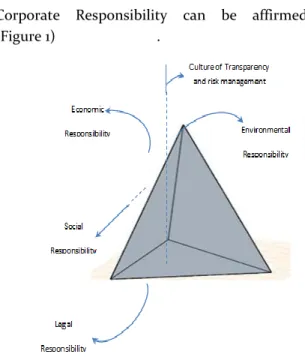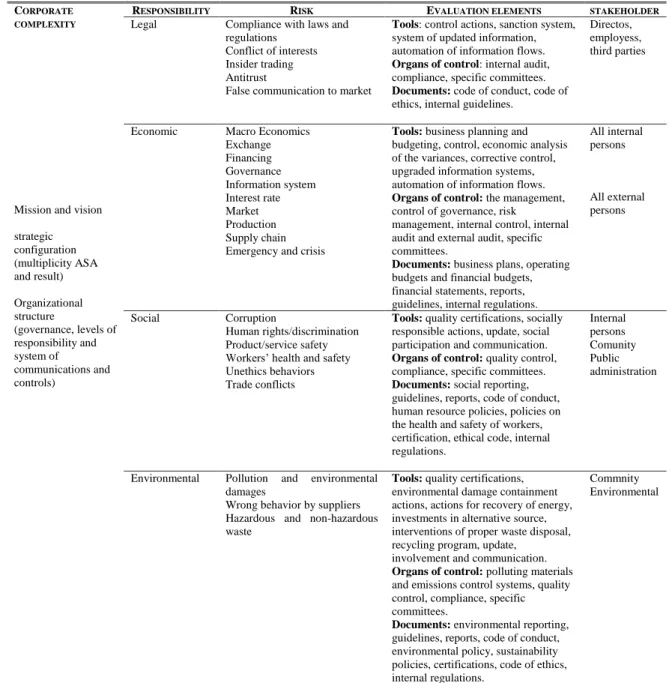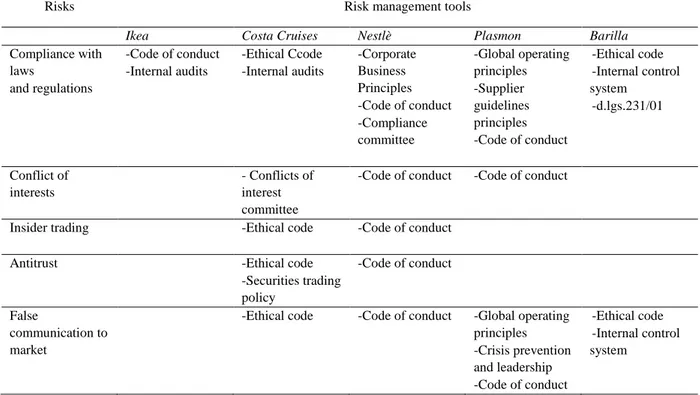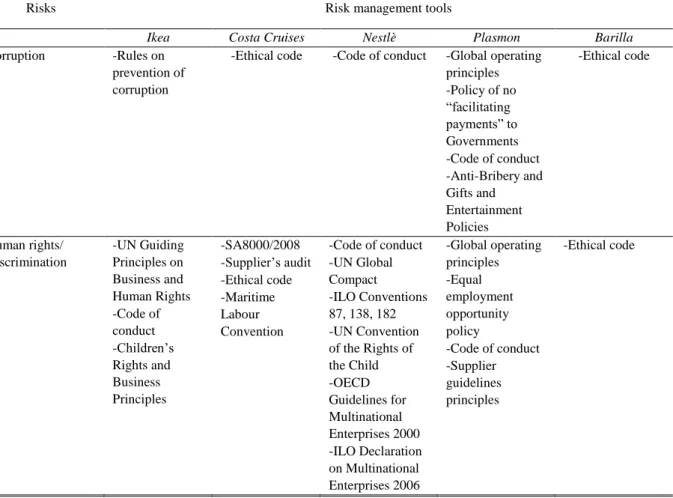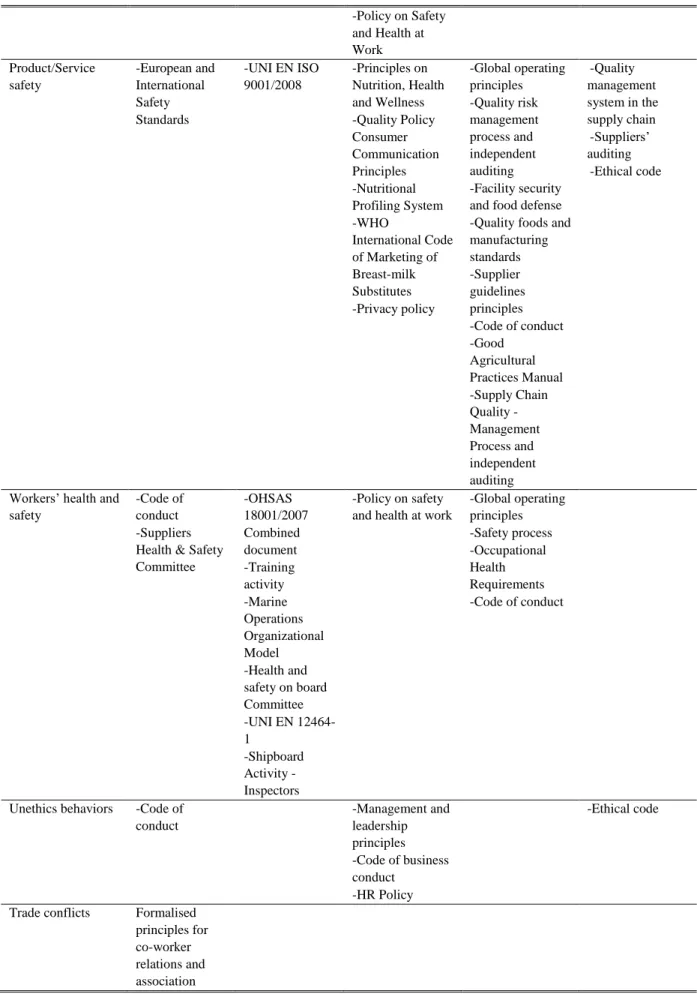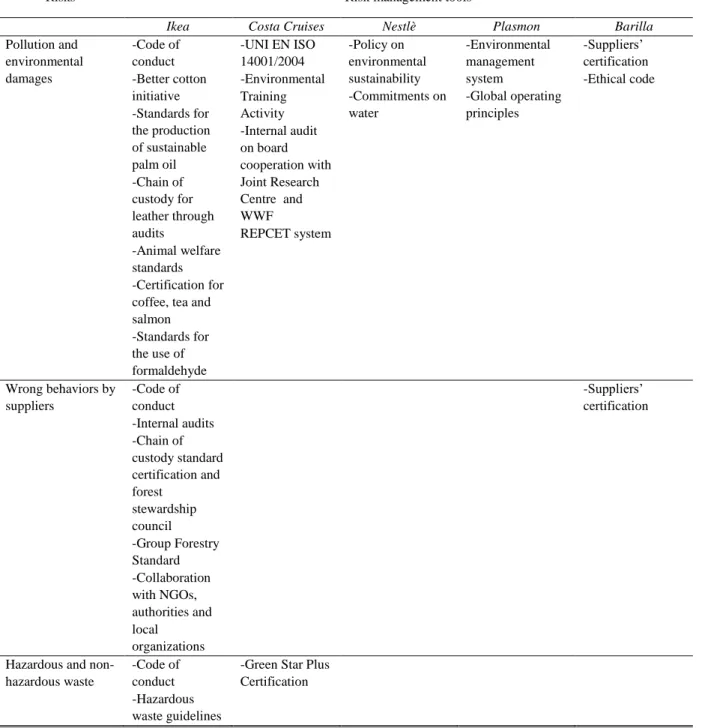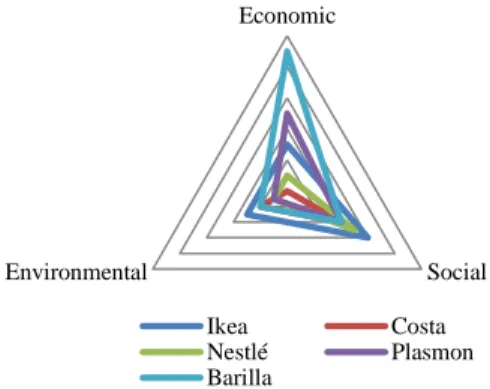Global Responsibility and Strategic Risk Management
Authors: Francesca Gennari, Department of Economics and Management, University of Brescia, Italy, [email protected]; Giuseppina Gandini, Department of Economics and Management, University of Brescia, Italy, [email protected]; Raffaella Cassano, Department of Economics and Management, University of Brescia, Italy, [email protected]
The emergence of a global business risk, caused by a more intense companies’ strategic and organizational complexity, leads both the researchers and the enterprises to a concept of a global responsibility as a paradigm for effective relationships with all stakeholders. This global concept of responsibility must include the areas of legal, economic, social and environmental commitment and suggests an integrated approach to risk management. The aim of this article is to propose a theoretical framework about the relations among stakeholders’ expectations, responsibility areas and risk management. By means of a qualitative analysis, the authors intend to suggest some reflections about the approach of some meaningful global companies towards their potential risks and the relationships with their stakeholders. Keywords: Global responsibility, risk management, corporate governance
Introduction
The globalization and the liberalization of the markets have altered the context of reference of the companies, leading to the intensification of quantity and diversity of business risks connected to the relationships and the interests of the different stakeholder's categories. The emergence of a global risk business, caused by a more intense strategic and organizational complexity, leads the researchers of business administration and management to a concept of responsibility more extended (global responsibility) as a paradigm for establishing effective relationships of trust with all stakeholders.
The possibilities for the companies to create lasting value, that can equitably meet numerous expectations of the stakeholders, needs therefore to adopt a strategy geared to business risk acceptance (strategic risk management) in order to effectively combine the need for flexibility, sharing efficiency and profitability with the affirmation of a responsibility more and larger.
The aim of the research is to investigate the relationship between strategic and organizational complexity, global responsibility and risk management, in order to define the essential conditions for companies’ global success (economic, competitive and social).
The analysis will be developed in two steps:
construction of a conceptual
framework that outlines the network for an effective and equitable management;
test of the theoretical framework by means of some significant international business cases.
Literature Review
The corporate crises, that have occurred in a global context at the beginning of this century, often associated with deficiencies in the system of governance, have led to a total
reconsideration of governance structures, processes and outcomes.
In particular, issues relating to the corporate governance system were considered by theoretical analyses by long time. This has led to an increasing emphasis on study and implementation of ‘good governance’ processes capable of equally balancing the various aspects of management business success.
The environmental turbulences are influenced by phenomena such as: globalization of markets and information; situations of diffused excess of supply over demand for goods; growth of complexity of intra and inter-company relations; relevance of the innovation capacity related to products and processes; opportunity for recovery of trust and consensus toward company’s goals. These phenomena have led to significant changes in the structures and processes of corporate governance.
In this context, the corporate governance shows a progressive expansion of its objectives, having an interest in the entire network of internal and external relations, in agreement with an approach based on
optimizing behaviors in relation to
stakeholders’ expectations and the exchange of information [1]-[2]-[3]-[4].
The corporate governance structure and connected responsibilities, that are assigned for the achievement of coordinated objectives in accordance with economic, social and environmental expectations, should avail itself of instruments of risk control [5].
The strategic vision of risk
management must support the entire control system of corporate structure, defining the network of company’s internal and external relations and identifying:
the protection units, responsible for the different types of control (economics and managerial ones and related to inside and outside relationships). This implies more and more extension of the control power to all stakeholders [6]-[7]-[8];
the risks to be addressed, concerning the various interconnected business areas. These risks require the adoption of a socially responsible strategy, not
only able to identify and recognize the risks, but also to turn them into favourable opportunities that create value and protect social interests [9]-[10]-[11]-[12]-[13]-[14].
A managerial approach, characterized by social responsible actions in the multiple relationships with all stakeholders, is able to ensure the creation of value in the long run, as long as it's able to prevent and drive the numerous business risks, especially those related to the environment, safety, future sustainability.
In a competitive global system, characterized by instability and turbulence, the corporate governance becomes more complex and uncertain and the ability to cope with negative events, on the one hand, and to seize the opportunity, on the other hand, gets essential [15].
It is, therefore, necessary to analyze the development of existing strategies to manage risks in front of different stakeholders’ changing expectations and to make the management aware of the need to pre-order, integrate and evaluate the metamorphosis of responsibility [11]-[16]-[17].
The risk’s governance, however, is connected to the company's ability to relate positively with its various social partners, to the quality of information and to the transparency of the communications. In this regard, it seems appropriate to emphasize that:
if the firm adopts models geared to sustainable development with the support of appropriate control tools, the risks will limited and the ability to limit the negative effects of the same will increase;
much more the company tends to favour approaches aimed at the attainment of profit, the larger will be the range of risks (for example, environmental and of image ones) and the governance will also become more difficult [18]-[19]-[20].
The strategic risk management should be direct to ensure the overall responsibility of the company in terms of profit objectives,
competitive success and sustainability in the long run [21]- [22].
The typical characteristics of the company as open and dynamic system will define the conditions for proper operation according to the effectiveness and the efficiency, these ones however briefly ascribable to the principle of profitability, in turn connected to the principle of sociality.
The constant compliance with the conditions of economic balance is strengthened if these conditions contemplate also stakeholders’ expectations [23]. In this way the connection between the economy and the sociality is indissoluble. It follows that the principle of profitability, that is company’s durability and autonomy, is conditioned by the legal requirements and cannot be separated from the careful consideration of social and environmental elements, in addition to the necessary search for optimization of economic performance.
The compliance with the conditions of effectiveness, instrumental to a socially responsible corporate conduct, requires the consideration of a broader concept of sociality, subtending the recognition of a complex system of shared values, inspired to the correctness, fairness, transparency and ethical behaviors. The affirmation of a broad concept of corporate responsibility involves a profound orientation of the corporate culture, the values permeating the top management and the organization.
In other words, the correct setting of a corporate governance system requires the observation of the dimensions of mentioned responsibility, although in the context of specific and transitional priority, in relation to the connected potential risk. It follows that the responsibility of the company cannot be separated into individual sizes because of the systemic character of the company and the consequent impact that every element has.
The combination of the individual dimensions identified, as a result of the joint and unitary participation at the long-term enterprise’s success, leads to a development of decisions and actions oriented to an equity treatment of all categories of stakeholders, so that the concept of three-dimensional
Corporate Responsibility can be affirmed
(Figure 1) .
Figure 1: The triple-dimensionality of corporate responsibility
It is not possible to predetermine a priority order among the dimensions of responsibility, because the relationship between the principle of profitability and sociality is mutual. However, the legal aspects compared to the other dimensions identified must be emphasized. In fact, the legal responsibility is the basis of reference upon which the entire system of corporate responsibility rests. In fact, while illegal actions may not be allowed, it is natural to experience operational decisions, variously compliant to optimal solutions to the conditions of profitability and/or sociality, closely linked to the assessment of the related risks.
These choices affect the company's activities, enhancing or limiting its ability to obtain results, and - from the perspective of business effectiveness – they should find motivation in the type and in the phase of life that the company is going through.
The described system requires a strong internal culture that permeating the company’s business, based on the values of transparency and fairness and the actual desire to create a shared and participatory corporate climate.
In other words, it becomes more and more critical and decisive the role of risk management, intended as a set of decisions and
actions oriented to monitor, map, anticipate and effectively manage the real or potential business risks in a strategic way.
This allows monitoring and managing the consequences that these risks may have on the different spheres of responsibility.
Risk Management and Theoretical
Framework
The construction of the framework involves first of all the analysis of governance models in order to understand if they are able to effectively meet the corporate responsibility, by means of the integrated government of the risk through the internal control system.
The strategic and organizational complexity of the company represents the
differential variable. In fact, it is not possible to establish an objectively responsible and effective model, but it is necessary to individually evaluate each case, in consideration of the company's internal and external variables and the characteristics of context that characterize the company's complexity.
In this regard it should be noted that, in proportion to the degree of strategic and organizational complexity (the first, understood as a multiplicity of technologies / products / markets combinations and the second linked to the widespread articulation of responsibilities) the relationships between management tools,
principals control and supporting
documentation for the monitoring of risks will be more articulate (Figure 2).
Figure 2: Company’s complexity and risk control
The construction of the framework is based on the link among: corporate governance
activity; prediction, prevention and
management of business risks; impact on stakeholders’ expectations and system of
internal control supervision. This framework emphasizes the network of internal and external relations, the different types of business risks related to the above relations, the trend and the possibilities of upgrading the overall company’s responsibility (Table I). Mere compliance of the
law and decisions of economic advantage
High complexity
Medium complexity
Organs of control, risk control organized, periodic reports (programmatic and finals)
Tools for managing the responsibility and risk management, timely reporting documents for the progress of the activities
Table 1. Framework Of The Relationship Among Responsibility, Risk And Corporate Complexity
The framework described will be observed in some corporate cases characterized by an high complexity with the objective of:
establishing a framework for the positioning of the selected companies, on the basis of the correlation among the strategic management, the risk control and the responsibility
expressed in the company’s
relationships;
expressing an opinion about the
consistency between external
communications aimed at obtaining consents and actual behaviours. For the purposes described above, we identified four companies belong to different sectors that operate at international level and which are, in the opinion of the authors, significant cases of study, considering their high strategic and organizational complexity.
Corporate Global Responsibility:
Some Business Cases
CORPORATE COMPLEXITY
Mission and vision strategic configuration (multiplicity ASA and result) Organizational structure (governance, levels of responsibility and system of communications and controls)
RESPONSIBILITY RISK EVALUATION ELEMENTS STAKEHOLDER
Legal Compliance with laws and regulations
Conflict of interests Insider trading Antitrust
False communication to market
Tools: control actions, sanction system,
system of updated information, automation of information flows.
Organs of control: internal audit,
compliance, specific committees.
Documents: code of conduct, code of
ethics, internal guidelines.
Directos, employess, third parties Economic Macro Economics
Exchange Financing Governance Information system Interest rate Market Production Supply chain Emergency and crisis
Tools: business planning and
budgeting, control, economic analysis of the variances, corrective control, upgraded information systems, automation of information flows.
Organs of control: the management,
control of governance, risk
management, internal control, internal audit and external audit, specific committees.
Documents: business plans, operating
budgets and financial budgets, financial statements, reports, guidelines, internal regulations.
All internal persons All external persons Social Corruption Human rights/discrimination Product/service safety Workers’ health and safety Unethics behaviors Trade conflicts
Tools: quality certifications, socially
responsible actions, update, social participation and communication.
Organs of control: quality control,
compliance, specific committees.
Documents: social reporting,
guidelines, reports, code of conduct, human resource policies, policies on the health and safety of workers, certification, ethical code, internal regulations. Internal persons Comunity Public administration
Environmental Pollution and environmental damages
Wrong behavior by suppliers Hazardous and non-hazardous waste
Tools: quality certifications,
environmental damage containment actions, actions for recovery of energy, investments in alternative source, interventions of proper waste disposal, recycling program, update,
involvement and communication.
Organs of control: polluting materials
and emissions control systems, quality control, compliance, specific committees.
Documents: environmental reporting,
guidelines, reports, code of conduct, environmental policy, sustainability policies, certifications, code of ethics, internal regulations.
Commnity Environmental
This paragraph aims at briefly describing some
business cases, meaningful for the
comprehension of the different approach that companies can have toward the management of their own potential risks. In particular, the analysis is qualitative and it is developed in these following steps:
identification of some global companies with an high economic, social and environmental impact, depending on their strategic and organizational complexity, typical activity and stakeholders categories. The strategic complexity must be interpreted as the number of strategic business units and
their connections, while the
organizational complexity as the
mandate to govern and the
relationships among staff in the company and in the company’s group;
analysis of all information and documents available in the company’s website, with the purpose to identify the company’s risk approach towards stakeholders and connected risk management tools;
classification of risk management tools on the basis of risk’s categories and
related areas of company’s
responsibility;
final considerations about the findings. The first business case is Ikea, global leader in the low-cost furnishing. This case, in our opinion, is very useful to show a wider and well-integrated approach of global corporate responsibility, managed in accordance with adequate and prudent business criteria. The most important steps of company’s history underline a strong social and environmental commitment, demonstration of responsible and
accountable culture.
Table 2: Ikea: Information About The Company (Www.Ikea.Com)
Vision/Mission To create a better everyday life for the many people Strategic
complexity
Operations in 44 countries, including 30 service trading offices in 25 countries, 33 distribution centres and 11 customer distribution centers. A total of 298 stores in 26 countries.
Organizational complexity
Stichting INGKA Foundation is the owner of INGKA Holding B.V. which is the parent company of IKEA Group of companies (Range Strategy & Product Development Supply Chain; IKEA Group Industry; IKEA Group Staff functions; IKEA Group Retail). In total, the IKEA Industry Group had 18,000 co-workers in 41 production units.
Documents available on website
Sustainability reports (since 2005 to 2012); Code of conduct (IWAY Standard) (2008);Yearly financial summary (2012); IKEA sustainability strategy for 2020 (2012).
Sustainability is integrated into IKEA management structure: the Chief Sustainability Officer is a member of the executive management team and reports directly to the Group President and CEO. As one of the cornerstones of “Growing IKEA Together” (the long-term business direction), sustainability is included in the annual business plans of every part of the business. Executive management and the board of directors receive regular reports on progress against IKEA key sustainability objectives and every co-worker at IKEA is responsible for making sustainability happen in their everyday work.
The second business case is Costa Cruises, the greatest Italian travel group and the first travel company in Europe. The shipwreck of Costa Concordia in the January 2012 near Giglio Island had highlighted serious omissions in the emergency operations and an inadequate policy of risk prevention. The accident had entailed effects on legal (observance of safety rules and personal responsibilities), economic (loss of ship’s value and reimbursement of damages), social (loss of human lives and emotional consequences) and environmental (sea pollution) spheres.
Table 3: Costa Cruises: Information About The Company (Www. Costacrociere.It)
Vision/Mission To take the world on vacation and deliver exceptional experiences through many of the world's best-known cruise brands that cater to a variety of different geographic regions and lifestyles, all at an outstanding value unrivaled on land or at sea.
Strategic complexity The Costa Group has 26 cruise ships in Mediterranean Sea, North Europe, Baltic Sea, Caribbean, Central America, South America, Arabs Emirates, Far East, the Red Sea. Costa Cruises has 14 ships for 250 destinations and 150 itineraries.
Organizational complexity
Costa Cruises belongs to Carnival Corporation Group, global leader with 10 brands, and has about19.000 workers.
Documents available on website
Sustainability repots (2005-2011); B.E.S.T. 4 Certification (2004); Ethical code
The B.E.S.T. 4 Certification (Business Excellence Sustainable Task Certification) summarizes a modern concept of company, based on the extension of traditional ideas of management excellence and value creation because of the inclusion of economics aspects in social and environmental contexts. Indeed, B.E.S.T. 4 is an articulated system of voluntary certifications, expression of an integrated policy with regard to quality, environment, safety and social responsibility. The B.E.S.T. 4 Certification applies to all ships in the Costa Cruises fleet and to all the facilities of Italian land. To obtain this certification the Company has undergone a profound organizational restructuring which refers to: the analysis of all business processes and their interactions; the examination of responsibility within each process; the identification of goals of future improvement.
There is a specific organizational unit (reporting to the Chairman and Chief Executive Officer) personally committed to the dissemination of the cultural values of the project. By this figure depends, directly, the Head of BEST 4 Planning Activities, responsible
for coordinating the system activity, and, functionally, the Process Owners identified for the 18 processes in which the company’s activities are organized. The contact persons for the application of the system on board ships are the Commanders.
The following business cases are useful to highlight different approaches towards situations characterized by potential risks and reputational damage for companies involved. In 2005 the Italian judiciary ordered the recall of certain batches of baby milk, due to the
presence of the substance
ITX-IsopropilThioXantone (a fixer for the ink used for the packaging of Tetrapak). Despite the European Food Safety Authority stated that the risk of effects if swallowed ITX is absent or negligible, Nestlé decided to withdraw their own milk marketed in Italy, France, Greece, Spain and Portugal. Furthermore, from that moment Nestlé committed itself to produce the packaging in a different print system, showing a behavior health-conscious and socially responsible.
Table 4: Nestlé: Information About The Company (Www.Nestle.Com)
Vision/Mission Each day we strive to make our products tastier and healthier choices that help consumers care for themselves and their families.
Strategic complexity
Nestlé Group works in Europe, Africa, Americas, Oceania, Asia with these products: powdered and liquid beverages, water and milk products, ice cream, nutrition and healthcare, prepared dishes and coking aids, confectionary and pet care for a total of 83 brands worldwide.
Organizational complexity
More than 450 affiliated and associated companies belong to Nestlé Group (headquartered in Switzerland).
Documents available on website
Financial statements (2000-2012); Corporate governance reports (2002-2013); Policy on environmental sustainability 2013; Water Stewardship Commitment 2013; Creating Share Value Report 2012; Supplier code 2010; Employee Relations Policy 2010; Management and leadership
principles 2009; Policy on Safety and health at work 2008; Consumer Communication Principles 2007; HR Policy 2002.
Nestlé Group Risk Management has established an uniform groupwide risk analysis framework, which is used to identify and quantify risks and opportunities in a consistent way within the company. A presentation of the risk management system has been provided in 2006.
Enterprise Risk Management Principles have also been updated and approved by the Executive Board in 2008. ERM is a structured process to identify and quantify risks and its possible impacts. It provides a decision support tool embedded in the management process; it is a self-assessment process with a multi-functional team approach integrated in the business and owned by the line management. Risk Management advisors act as facilitator. This approach allows raising awareness provides a full risk overview, proactively manages emerging issues.
The last business case Plasmon-Barilla shows different transparency approach in communication to consumers.
At the end of 2011 Plasmon (belonging to H.J. Heinz Company, the most global of all
U.S.- based food companies) denounced that the competitor Barilla had introduced in its brand products a particular type of pasta called “Piccolini” addressed to children but without any specification regards the age group. Plasmon observed that the “Piccolini” were inappropriate for children between 0-3 years.
Barilla decided not to change the name of the product and to do not make some clarifications on the packaging of the same, leaving the responsibility of purchase to parents. In the spring of 2012, the court of honor imposed on Barilla to make some corrections to the advertising of “Piccolini”, in order to make it clear that this type of paste is designed for children with more than three years, requiring changes also in the packaging. If Barilla had intervened before the interference of the court of honor, the conclusion of the facts would have been the same, but the effect on consumers would have been very different in term of perception about company’s social responsibility.
Table 5: Plasmon: Information About The Company (Www.Plasmon.It, Www.Heinz.Com)
Vision/Mission As the trusted leader in nutrition and wellness, Heinz – the original Pure Food Company – is
dedicated to the sustainable health of people, the planet and our Company
Strategic complexity H.J. Heinz Company, headquartered in Pennsylvania, operates in 200 countries around the world with 15 brands
Organizational complexity Heinz Company was acquired by Berkshire Hathaway and 3G Capital in 2013. Documents available on
website
Annual reports (2000-2012); Global Operating Principles 2012; CSR Report 2011; Code of conduct 2010; Communication and Marketing Guidelines; Supplier Guidance Principles
The Heinz Group incorporates a broader integrated operational approach to the Enterprise Reputation and Risk Management (ER²M) function. The Office of Risk Management is established at World
Headquarters under an Executive Vice President and it includes ER²M, Product Quality and Safety, and Operational Risk Management functions. This department reports to the Audit Committee of the Board of
Directors as needed.
Table 6: Barilla: Information About The Company (Www.Gruppobarilla.It)
Vision/Mission We help people live better, bringing every day in their lives the well-being and joy of eating well.
Strategic complexity Barilla operates in about 100 countries with about 1000 products (baked goods, pasta and sauces) with 13 brands.
subsidiaries for a total of 13.000 workers. Documents available on
website
Sustainable Business Reports (2009-2013); Annual Report 2011; Ethical Code 2005
Barilla has explicitly undertaken from 2010 a path that has led to the determination of both the right level of risk appetite (Financial & Reputational Risk Appetite) and the shared enterprise-wide metrics for the evaluation of each event. Furthermore, the register of business risks (Risk Register) identifies the risk areas to which the company is potentially exposed and the allocation of responsibility to organizational (Risk Ownership). In addition, in 2011, projects have been carried out to assess the priority risk areas for the company.
The following Tables show a
comparative analysis of the companies analyzed with the aim to describe their approach regards a global risks management. We have caught the risk management tools, connected with the different areas of responsibilities, in the documents available on the websites. In our opinion they express the companies’ approach toward the risk management and the
transparency in communication toward
stakeholders (at any rate in official way).
Table VII compares the risk
management tools related to the legal responsibility for the companies analyzed.
Table 7:: Legal Responsibility
Risks Risk management tools
Ikea Costa Cruises Nestlè Plasmon Barilla
Compliance with laws and regulations -Code of conduct -Internal audits -Ethical Ccode -Internal audits -Corporate Business Principles -Code of conduct -Compliance committee -Global operating principles -Supplier guidelines principles -Code of conduct -Ethical code -Internal control system -d.lgs.231/01 Conflict of interests - Conflicts of interest committee
-Code of conduct -Code of conduct
Insider trading -Ethical code -Code of conduct
Antitrust -Ethical code
-Securities trading policy -Code of conduct False communication to market
-Ethical code -Code of conduct -Global operating
principles -Crisis prevention and leadership -Code of conduct -Ethical code -Internal control system
Table VIII compares the risk management tools related to the economic responsibility for the companies analyzed.
Table 8: Economic Responsibility
Risks Risk management tools
Ikea Costa Cruises Nestlè Plasmon Barilla
Macro economics
-Specific policies
Exchange -Internal control
system
Financing -Specific policies
Governance -Specific policies
Information system -Internal control system -Disaster recovery service -Vulnerability assessment activities
Interest rate -Internal control
system
-Specific policies
Market -Specific policies
Production -Good manufacturing practices -HACCP system -Good distribution practices -Quality audit on sale point
Supply chain -Code of conduct
-Internal audits -Audits by suppliers
-Supplier code -Supplier
guidelines principles -Code of conduct Emergency and crisis -Business continuity plan -Specific policies
Table IX compares the risk management tools related to the social responsibility for the companies analyzed.
Table 9: Social Responsibility
Risks Risk management tools
Ikea Costa Cruises Nestlè Plasmon Barilla
Corruption -Rules on
prevention of corruption
-Ethical code -Code of conduct -Global operating principles -Policy of no “facilitating payments” to Governments -Code of conduct -Anti-Bribery and Gifts and Entertainment Policies -Ethical code Human rights/ Discrimination -UN Guiding Principles on Business and Human Rights -Code of conduct -Children’s Rights and Business Principles -SA8000/2008 -Supplier’s audit -Ethical code -Maritime Labour Convention -Code of conduct -UN Global Compact -ILO Conventions 87, 138, 182 -UN Convention of the Rights of the Child -OECD Guidelines for Multinational Enterprises 2000 -ILO Declaration on Multinational Enterprises 2006 -Global operating principles -Equal employment opportunity policy -Code of conduct -Supplier guidelines principles -Ethical code
-Policy on Safety and Health at Work Product/Service safety -European and International Safety Standards -UNI EN ISO 9001/2008 -Principles on Nutrition, Health and Wellness -Quality Policy Consumer Communication Principles -Nutritional Profiling System -WHO International Code of Marketing of Breast-milk Substitutes -Privacy policy -Global operating principles -Quality risk management process and independent auditing -Facility security and food defense -Quality foods and manufacturing standards -Supplier guidelines principles -Code of conduct -Good Agricultural Practices Manual -Supply Chain Quality -Management Process and independent auditing -Quality management system in the supply chain -Suppliers’ auditing -Ethical code
Workers’ health and safety
-Code of conduct -Suppliers Health & Safety Committee -OHSAS 18001/2007 Combined document -Training activity -Marine Operations Organizational Model -Health and safety on board Committee -UNI EN 12464-1 -Shipboard Activity -Inspectors -Policy on safety and health at work
-Global operating principles -Safety process -Occupational Health Requirements -Code of conduct
Unethics behaviors -Code of conduct -Management and leadership principles -Code of business conduct -HR Policy -Ethical code
Trade conflicts Formalised
principles for co-worker relations and association
Table X compares the risk management tools related to the environmental responsibility for the companies analyzed.
Table 10: Environmental Responsibility
Risks Risk management tools
Ikea Costa Cruises Nestlè Plasmon Barilla
Pollution and environmental damages -Code of conduct -Better cotton initiative -Standards for the production of sustainable palm oil -Chain of custody for leather through audits -Animal welfare standards -Certification for coffee, tea and salmon -Standards for the use of formaldehyde -UNI EN ISO 14001/2004 -Environmental Training Activity -Internal audit on board cooperation with Joint Research Centre and WWF REPCET system -Policy on environmental sustainability -Commitments on water -Environmental management system -Global operating principles -Suppliers’ certification -Ethical code Wrong behaviors by suppliers -Code of conduct -Internal audits -Chain of custody standard certification and forest stewardship council -Group Forestry Standard -Collaboration with NGOs, authorities and local organizations -Suppliers’ certification
Hazardous and non-hazardous waste
-Code of conduct -Hazardous waste guidelines
-Green Star Plus Certification
All the companies analyzed are characterized by an high level of strategic and organizational complexity (see Tables from II to VI). This situation leads us to think that these companies have to satisfy a wide range of expectations by very different stakeholders’ categories. Consequently, the potential risks
connected with external and internal relations solicit a global risk management - by means of control safeguards, risk safeguards, recurrent forecast and final documents - related to a global enterprise’s responsibility.
Only some companies explicitly declare to have an integrated project for the risk
management. In general we can say that the companies subject of our research mainly oversee the risks connected with their typical activity and in accordance with their complexity level.
Considering that the respect of laws and rules in force (legal responsibility) is the indispensable condition for the company’s behaving in the legal context (Table VII), the cross-analysis shows that (see Tables from VIII to X):
the companies are inclined to partially communicate their approach towards risks specifically connected with the economic responsibility; probably because of the management of these risks is implicit in the financial values and company’s performance;
considering the various documents available on websites, the companies seem to pay attention to the communication of risk management
tools related to social and
environmental responsibilities;
on the one side, we can gather from the analysis the companies’ will to communicate to stakeholders their commitment toward a concept of global responsibility and strategic risk management. On the other side, the transparency in information not always finds a correspondence in coherent behaviors against particular situations, with the real risk to damage the company’s reputation and image in very little time. This fact expresses a corporate culture still immature with reference to a strategic and integrated concept of risk‘s responsibility.
Figure 3: Companies’ global responsibility and risk management
Conclusions
The expansion of the boundaries of business competition, due to the phenomenon of globalization and the increasing complexity of the supply system, requires a more careful consideration of the business risks in respect of a global vision.
The awareness of the responsibility of acting by companies is not limited to the areas of legality and profitability, but extended to aspects of social and sustainability. On the one hand, this facilitates the establishment of long-lasting relationships with stakeholders, relationships based on transparency in behaviors, on a corporate culture characterized by the principle of equity and on external communication. On the other hand, the acceptance of global responsibility leads companies to strategies geared to business risk acceptance (strategic risk management).
The strategic vision of risk
management must support the domain of the control systems as provided by the corporate governance structure, with the ability to identify and manage risks. In this regard it should be noted that control tools and supporting documentation for the risks’ monitoring will be differently structured in proportion to the degree of strategic and organizational complexity and relationships among management tools.
The analysis conducted on a group of significant companies confirms that companies
Economic Social Environmental Ikea Costa Nestlé Plasmon Barilla
with high level of strategic and organisational complexity share a concept of global responsibility as a reference for the strategic decisions and they are aware of the importance of a systemic vision of risk management.
There are, however, chance for improvement with regard to relations with
stakeholders. The voluntary publication of documents and communication of company’s strategy about risk management are merely formal acts if they are not inspired by a mature corporate culture where transparency in the communication reflects fair and respectful to all stakeholders’ expectations behaviors.
References
[1]. D.M. Salvioni, “Corporate effectiveness governance processes and intangible resources”, in D.M. Salvioni (ed.), corporate Governance, management control and intangible resources, FrancoAngeli, Milan, (in Italian), 2004.
[2]. A. Trobia, and V. Milia, Social Network Analysis. approaches, techniques and new applications, Carocci, Rome, (in Italian), 2011
[3]. P. Carrington, J. Scott, and S. Wasserman, “Models and Methods in Social Network Analysis”, Cambridge University Press, Cambridge (MA), 2005.
[4]. J. Scott, Social Network Analysis. A Handbook, London, Sage, 2000.
[5]. R. Cassano, “Internal Auditing System”, in Salvioni D. M. (ed.), Corporate governance, control and trasparency, FrancoAngeli, II° Edizione, Milan, (in Italian), 2009.
[6]. K. Davis, “Five proposition for social responsibility”, Business Horizons, V. 18, n. 3, 1975.
[7]. C. Mio, Corporate social responsibility and control system: towards integration, FrancoAngeli, Milan, (in Italian), 2005.
[8]. R. Cassano, “Corporate governance, social responsibility and communication”, in Salvioni D. M. (ed.), Corporate governance, management control and intangibles, FrancoAngeli, Milan, (in Italian), 2004.
[9]. M. Cruz, Modeling, Measuring and Hedging Operational Risk, Wiley Finance, 2005.
[10].P.Bastia, “Risk profiles of the financial management in the processes of firm growth”, Finance and Industry in Italy, Il Mulino, Bologna (in Italian), 2007.
[11]. F. Perrini, and A. Tencati, Corporate social responsibility. A new strategic approach to business management, Egea, Milan, (in Italian), 2008.
[12]. N. Baker, “Managing the Complexity of Risk”, Internal Auditor, vol. 68, n. 2, pp. 35-38, 2011. [13]. S. Zadek, The civil corporation, ed. Earthscan, London and Sterling Va, 2001.
[14]. G. Gandini, and F. Gennari, “The Risk in Corporate System”, Prandi P. (ed.), The Risk Management, FrancoAngeli, Milan (in Italian), 2010.
[15]. F. Gennari, “The Role of Institutional Subjects in Corporate Risk Management”, Prandi P. (ed.), The Risk Management, FrancoAngeli, Milan (in Italian), 2010.
[16]. M. E. Porter, and M. R. Kramer, “Strategy and society. The link between competitive advantage and corporate social responsibility”, Harward Business Review, 2006.
[17]. G. Rusconi, and M. Dorigatti, Social Responsibility, FrancoAngeli, Milan, (in Italian), 2004. [18].G. Gandini, Internal Auditing and Risk Management in Corporate Governance, FrancoAngeli,
Milan (in Italian), 2004.
[19]. G. Gandini, Risk Management and Controls, FrancoAngeli, Milan (In Italian), 2013. [20]. R. Tummala, and T. Schoenherr, “Assessing and managing risks using the Supply Chain
Risk Management Process (SCRMP)”, Supply Chain Management: An International Journal, Vol. 16 Iss: 6, 2011, pp.474 – 483.
[21]. F. Gennari, “Subjects of the Process of Risk Assumption”, Gandini G. (ed.), Risk Management and Controls, FrancoAngeli, Milan (in Italian), 2013.
[22]. R. Cassano, “Auditing to Risk management”, in Gandini G. (ed.), Risk management and external control, FrancoAngeli, Milan, (in Italian), 2013.
[23]. G. Gandini, “Compliance and Prevention of Other Associate Risks”, Prandi P. (ed.), The Risk Management, FrancoAngeli, Milan (in Italian) 2010.
